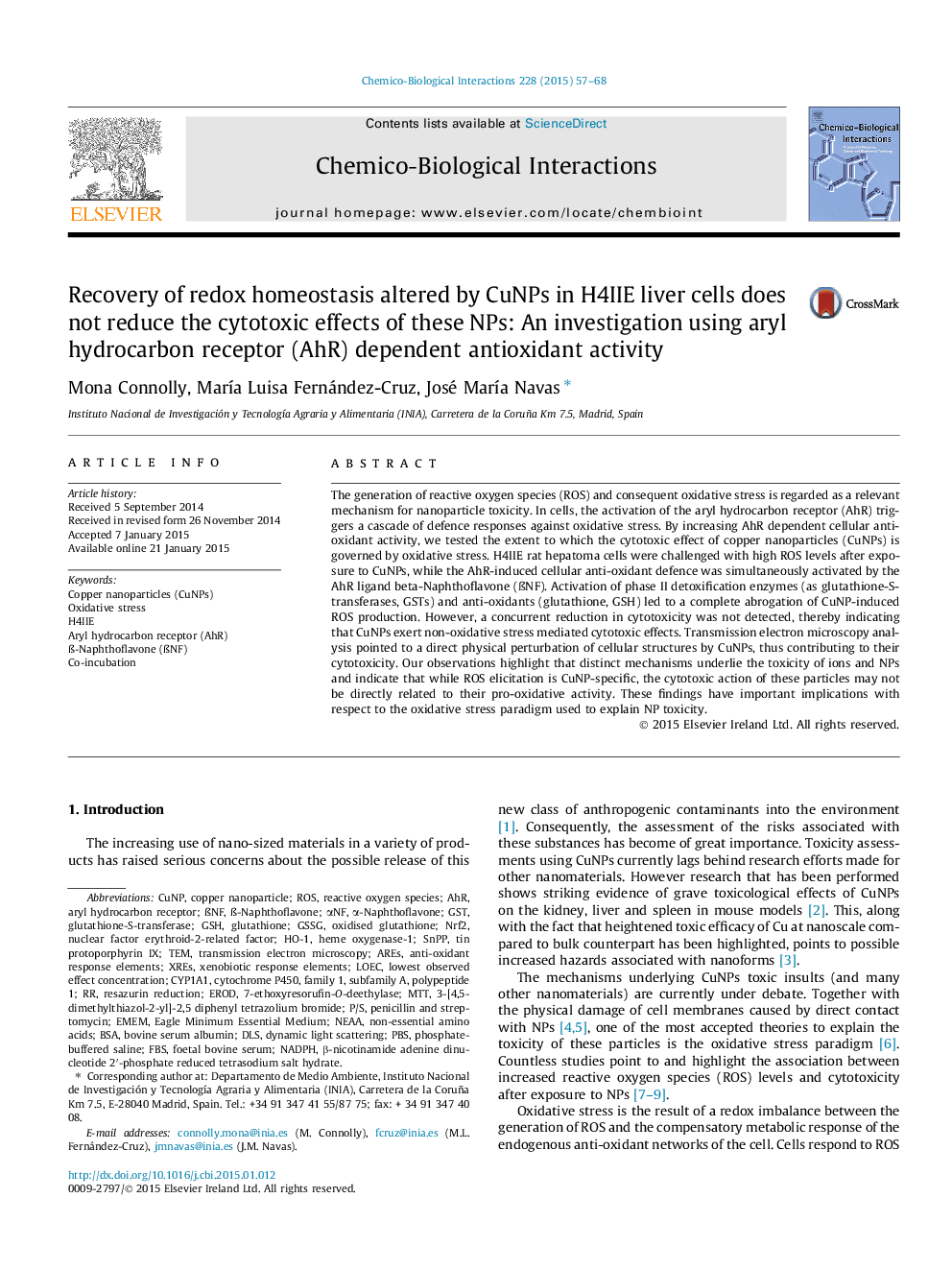| کد مقاله | کد نشریه | سال انتشار | مقاله انگلیسی | نسخه تمام متن |
|---|---|---|---|---|
| 5847942 | 1561613 | 2015 | 12 صفحه PDF | دانلود رایگان |
عنوان انگلیسی مقاله ISI
Recovery of redox homeostasis altered by CuNPs in H4IIE liver cells does not reduce the cytotoxic effects of these NPs: An investigation using aryl hydrocarbon receptor (AhR) dependent antioxidant activity
دانلود مقاله + سفارش ترجمه
دانلود مقاله ISI انگلیسی
رایگان برای ایرانیان
کلمات کلیدی
Heme oxygenase-1GSTHO-1GSSGERODCYP1A1LOECAREsanti-oxidant response elementsDLSEMEMSNFNEAA7-ethoxyresorufin-O-deethylaseαNFcytochrome P450, family 1, subfamily A, polypeptide 1H4IIECo-incubationGSHPBSAHRFBSNrf2NADPHBSA - BSAMTT - MTTP/S - P / SROS - ROSSnPP - SNPPα-Naphthoflavone - α-نفتوفلوانbovine serum albumin - آلبومین سرم گاوnon-essential amino acids - اسید آمینه غیر ضروریTem - این استOxidative stress - تنش اکسیداتیوfoetal bovine serum - سرم جنین گاوPhosphate-buffered saline - محلول نمک فسفات با خاصیت بافریTransmission electron microscopy - میکروسکوپ الکترونی عبوریcopper nanoparticle - نانوذره مسDynamic Light Scattering - پراکندگی نور دینامیکیtin protoporphyrin IX - پروتوپورفیرین IXpenicillin and streptomycin - پنی سیلین و استرپتومایسینlowest observed effect concentration - کمترین اثر غلظت مشاهده شدهGlutathione - گلوتاتیونglutathione-S-transferase - گلوتاتیون S-ترانسفرازoxidised glutathione - گلوتاتیون اکسید شدهReactive oxygen species - گونههای فعال اکسیژنaryl hydrocarbon receptor - گیرنده آرویل هیدروکربنAryl hydrocarbon receptor (AhR) - گیرنده هیدروکربن آریل (AhR)
موضوعات مرتبط
علوم زیستی و بیوفناوری
علوم محیط زیست
بهداشت، سم شناسی و جهش زایی
پیش نمایش صفحه اول مقاله

چکیده انگلیسی
The generation of reactive oxygen species (ROS) and consequent oxidative stress is regarded as a relevant mechanism for nanoparticle toxicity. In cells, the activation of the aryl hydrocarbon receptor (AhR) triggers a cascade of defence responses against oxidative stress. By increasing AhR dependent cellular anti-oxidant activity, we tested the extent to which the cytotoxic effect of copper nanoparticles (CuNPs) is governed by oxidative stress. H4IIE rat hepatoma cells were challenged with high ROS levels after exposure to CuNPs, while the AhR-induced cellular anti-oxidant defence was simultaneously activated by the AhR ligand beta-Naphthoflavone (ÃNF). Activation of phase II detoxification enzymes (as glutathione-S-transferases, GSTs) and anti-oxidants (glutathione, GSH) led to a complete abrogation of CuNP-induced ROS production. However, a concurrent reduction in cytotoxicity was not detected, thereby indicating that CuNPs exert non-oxidative stress mediated cytotoxic effects. Transmission electron microscopy analysis pointed to a direct physical perturbation of cellular structures by CuNPs, thus contributing to their cytotoxicity. Our observations highlight that distinct mechanisms underlie the toxicity of ions and NPs and indicate that while ROS elicitation is CuNP-specific, the cytotoxic action of these particles may not be directly related to their pro-oxidative activity. These findings have important implications with respect to the oxidative stress paradigm used to explain NP toxicity.
ناشر
Database: Elsevier - ScienceDirect (ساینس دایرکت)
Journal: Chemico-Biological Interactions - Volume 228, 25 February 2015, Pages 57-68
Journal: Chemico-Biological Interactions - Volume 228, 25 February 2015, Pages 57-68
نویسندگان
Mona Connolly, MarÃa Luisa Fernández-Cruz, José MarÃa Navas,